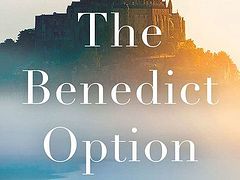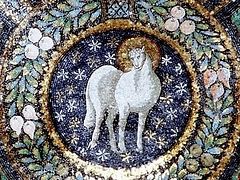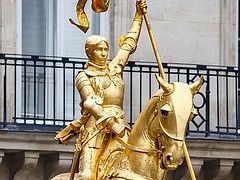You boast, “We have entered into a covenant with death, with the realm of the dead we have made an agreement. When an overwhelming scourge sweeps by, it cannot touch us, for we have made a lie our refuge and falsehood our hiding place.” (Isaiah 28:15)
— Have you made a covenant with Victory?
— We have made a covenant with Death.
(Claude Basire, the Mountaineer, the member of the National Convention of the Republic of France. June 18, 1793.)
—…I shall be Death then.
— You, to be Death!.. For God’s sake, forbear!
— What’s wrong with me being Death?
— I see you as Life!
— Yet Death I shall be! But fear me not: I’ll be an easy death, with visions of beauty and the ecstasy of life. Come on, give me your hand.
(Glafira Bodrostina and Andrey Podozerov’s conversation in At Knives Drawn, N.S. Leskov)
Since the time of Renaissance and Enlightenment, modernity has never been simply a chronological, but an ideological concept. It was formulated in its present meaning by the ideologists of the Enlightenment: modernity always stands in opposition to the traditional society worldview, bears no correspondence to the past and “the old” and has no continuity with the social experience and tradition.
The concept of “modernity” (Modern) has been regularly present in European languages since the late seventeenth century. “The dispute on the ancient and the new” (“Querelle des Anciens et des Modernes”) at the French Academy marked the period in which “modernity” and “ancient” tradition finally became mutually exclusive opposites. The concept came into existence together with the twofold, and later threefold division of history into Ancient Times, Middle Ages and New Times at the age of Petrarch, Bruno and Biondi. This kind of division broke the history down into independent stages, with each of them opposing the previous one, thus transforming chronology into ideology. In this sense, the word “modernity” came to mean “rejection” in philosophical thought. Therefore, in today’s language, “modernity” is used to mean the opposite of tradition: tradition cannot be modern, modernity cannot be traditional.
Gradually, with the passing of time, the word “modernity” lost the ideological features developed by humanist philosophers, and came to mean simply the present moment, as of today. Modernity became a reflection of the Enlightenment “Modernity doctrine”, which consists of the idea of Man’s superiority over God (humanism) and the need of absolving culture of religious consciousness (secularism). In fact, all the ideas of New and Modern Times that constitute the frame of our thinking, from rationalism to standalone ethics and postmodern relativism, take root in those basic postulates.
The ideological character of modernity is ubiquitous and can be easily detected in the language. Wherever the word “modernity” is applied, it gives whatever it describes a certain character. Thinking about something modern, we always carry in mind the ideas of Enlightenment and Modernity, of forever opposing tradition for the sake of something new.
Whatever we designate as modern attains a certain value and becomes “non-traditional”, “non-classical”, secular and humanistic, as is the case with modern art, modern philosophy, modern education, modern family, modern morality and modern love.
Try applying the attribute “modern writer” to living authors, and you will see that it suits them all in a different degree, and some will appear more modern than others. We are not ready to award every living person with being “modern”. Even with the word used in its most neutral sense, as with “modern equipment,” we still bear in mind the existence somewhere of worthless old equipment that is now history.
“Modern” in our language invariably means something good, whereas “traditional” describes something old and less attractive.
While anything “traditional” may also be viewed as “proper” and “reliable,” it will almost always be “banal” and “boring,” devoid of future and vitality, often with dark and repulsive undertones. From the point of view of today, “tradition” smells like dust in a provincial museum and strives to lure us into the darkness of folk cultures and archaism. Even the “good old” component fails to endow “tradition” with benefits, since both the price and value of “old” are designated by “modernity”. “Modernity” keeps tradition in control in a specially designed ghetto, where people are expected to watch it through the fence and comment: “It takes all sorts to make the world.”
One of the worst possible nightmares for a modern man is to be ejected from the present and be termed as “outdated” and “marginal”. We could say that a modern man’s internal creed is expressed in the formula: “I am modern, therefore I exist”.
The five hundred-year-old process of modernity replacing tradition has a rich history. Displacement of the Church from secular space provides the most striking example: Reformation placed the Church under the rule of the secular state, the bourgeois revolutions replaced religious ethics with secular ones, and rationalism later used secular ideals to design the scientific way of thinking, which was basically neo-religious. Today, this process is dispersed into parts, but continues riding the same line. And within many centuries, the logic has remained unchanged—to limit the influence of the traditional part of society: do not spread the norms of your tradition to the present, live according to your rules only in a specially designated territory, and in other cases—submit to “the modernity”. Over centuries, the process has retained its logic: to limit the possible influence of the traditional part of society by placing it firmly behind the Church fence. “Modern” thinking has always acted out one scenario: to present religious culture as subjective, to regulate it by narrowing its discursive, sociocultural, and physical presence, to separate it from the general (i.e. secular) culture. When the assigned space becomes too narrow, the representatives of religious traditions are physically exterminated, as they were a hundred years ago in Russia, at the start of the Church persecution. In the abstract sense, “modernity” serves as neutral ground, a kind of common denominator and a universal point of reference. In reality, however, “modernity” is both an ideological doctrine and an ideological practice, which not only restricts tradition, but places it in a linguistic and cultural ghetto, less than a step away from the actual ghetto, prison and concentration camp.
The power of language and “discourse” was noted by a number of the twentieth-century authors, especially the postmodernist philosophers who made it one of the dominant themes of their research (Liotard, Derrida, Foucault, Baudrillard, Barthes, Deleuze, Guattari, and others). The common goal of postmodernism was total demolition of all that still contained the remnants of tradition. These authors critically dissected the “discursive power” mechanisms of traditional thinking and encouraged readers to “go beyond” the old clichés and concepts. The readers should also be aware of such linguistic situations where language as a semiotic system or discourse has the power to “control and suppress,” by establishing a system of hierarchy and subordination (as, for example, in the language of hospitals, armies and schools). They were urged to tear down these limits, and to think “freely” in revolutionary ways. In some cases, the post-modernists went so far as to propose to abandon the language of science itself as too dogmatic, logical and hierarchical, which made it “outdated”, as described by Bricmont and Sokal in their book Fashionable Nonsense. As for the language of religion, it has long been thrown overboard as “archaic,” both in the socialist and capitalist world.
Viewing themselves as the new generation that broke apart the foundations of the “modern” culture, postmodernists, however, belonged to the same paradigm as the first European humanists. Their fight with tradition stemmed from them understanding “modernity” (which they called “postmodernity”) exactly in the same way as their predecessors—as the need to overcome tradition. The reason why the twentieth century failed to make the transition to a fundamentally new era, or invent a new way of thinking, is that it was busy continuing under other names, the process that began at New Times: the struggle with the “old” and traditional in favor of everything humanistic and secular.
***
Meanwhile, the feeling of fundamental changes approaching is getting to be over a hundred and fifty years old. Almost everyone now is sure of the inevitable change, which first became apparent to philosophers and culturologists, and then to politicians and ordinary people. This is the source of a number of similar concepts such as the end of the New Times, the sunset of the Enlightenment and the end of history. On the background of the early twentieth-century social passions, the feeling of change was especially evident. For N. A. Berdyaev, the end of “modernity” occurred in the late 1910s, when he wrote the following lines in revolutionary Russia: “There is no return to the humanist morality, art, and the humanistic way of learning. Some kind of irreparable catastrophe has happened to the destiny of man, his human anguish, the inevitable disaster of his transition from human self-assertion to human self-denial... This terrible revolution is bringing an end to the history of the New Times and opening a new era”.1 The question of what kind of era was going to replace the “new,” “modern” history naturally arose. Berdyaev proposed to call it the “New Middle Ages,” predicting the inevitable crisis of rationalism philosophy, humanism and secularism in European thought and the new religious revival and the return of the religious consciousness to all spheres of human activity according to the medieval model.
The twentieth century, however, did not see the end of “modernity”. On the contrary, the last century saw its onslaught intensify as it struck the last remaining bastion of tradition with all the accumulated power. It was also in the twentieth century that the main ideas of “modernity” since the Enlightenment—secularism and humanism—became absolutely dominant. The victory of secularism was symbolically expressed in the atheist ideology of the USSR, and the victory of humanism—by the human rights doctrine in the capitalist countries. The twentieth century had the chance of obtaining the label of the most “modern” age, wherein the ideals of Enlightenment had found their ultimate embodiment.
That is exactly why official science had failed to come up with a better term than “Modern Times,” as something even more new, to designate the period of history which began at the beginning of the twentieth century. In the sphere of art, “modern” came to be called “contemporary” (contemporary art is believed to have replaced modern art), although there is no more real difference between “modern” and “contemporary” than between “modern” and “new”. In fact, their essence is the same. Both “Modern Times” and “contemporary art” are a continuation of the same “modernity”.
Today we dare make a new assumption: the crisis in all spheres from economy to culture that the world is facing today is linked to the crisis of “modernity” and the contradictions within this doctrine. The crisis comes from the unspoken principle of this doctrine: “be modern or die.” As being “modern” is the same as being licensed to live, it is therefore the common goal that countries, peoples, cultures, economies and religions are striving to achieve. But since “modernity” is based upon the total rejection of anything old-fashioned or traditional, it cannot by its nature become all-embracing. It does, however, possess a number of methods that allow the system to prolong its existence by destroying those who do not conform to it. The arsenal includes colonial wars, bombings, sanctions, caricatures and information pressure.
As of today, traditional religious societies of Asia and the East and conservative Christians of Europe and America are ready to become “modern” in appearance, but retain their tradition in substance. Modernity, however, prevents them from joining itself by putting forward an impossible condition to acknowledge the supremacy of human rights and freedoms over the moral laws of traditional cultures.
Not so long ago, people, societies and ideas were ready to fulfill a number of modernity”s requirements (which were not quite so harsh), and accept modern values, rules and institutions for the sake of association. Today, as if they sense the end approaching and the catastrophic reduction of space, people storm it with no regard for formalities, burst in without entrance exams, without abandoning their traditional values and with little knowledge where they go or why. By and large, they have no need for “modernity”. What they need is survival and escape from physical destruction.
The burning question of today is whether the “modernity” doctrine has now become redundant and ought to be replaced. Philosophers have been trying to rethink “modernity” through neo-archaism, the New Middle ages, post-post-modernity and other equally artificial constructions. It is significant that today’s culture is dominated by archaic, medieval, and futuristic stories. None of these forms, however, is able to offer a sense of perspective. They all set out to fight modernity with its primary weapon—rejection—and are therefore unable to create anything fundamentally new, while busily reproducing the same “modernity” discourse in different forms and stage decorations.
It is impossible to destroy or rethink “modernity” by negation and revolution, because “modernity” itself is the embodiment of negation and revolution. Every attempt at rethinking will only engender a new, but essentially the same old “modernity”. To really overcome “modernity”, it is necessary to change our way of thinking about it and to deprive it of the values of Enlightenment and the spirit of struggle with tradition.
Tradition is often correctly described as the continuity of the historical continuum, the connection between the past and the present and the transmission of experience from generation to generation. Hence our habitual association of tradition with something ‘old, ‘past’ and ’historic’. Yet both history and time only serve to clarify the concept of tradition, while the phenomenon itself is timeless by nature and does not belong to historic periods. Tradition is our compensation for the fluidity and elusiveness of the present moment and our way to overcome chronological time, mortality and death. Tradition encompasses both the ultimate past and the ultimate future, which are the two halves of eternity. Tradition allows you to feel the eternity and live in it during your finite, earthly life. And in this sense, tradition gives you everlasting life.
The kind of “modernity” created by the humanists is constantly pushing tradition away and linking human thinking to the feeling of immediacy, temporality and mortality. “Modernity” is still divorced from the past and the future and appears as a fleeting moment, a movement, something ever-changing, elusive and unique. Tradition, however, is not about the past, but about eternity. Therefore, by pushing away from tradition, humanistic “modernity” does not move forward on the scale of historical time, but moves ‘away from’ eternity. ‘Away from’ eternity does not mean into the future or into the past; it is the direction contrary to eternity, to the end of all things, to death. It is not only modern art, but also “modernity” itself, that is obsessed with the idea of death. That is the reason why humanistic “modernity” lacks eschatological fear: it does not wait for death or fight it, but welcomes it and brings it nearer. In this sense, “modernity” is death.
It is only with the help of religious thinking that the enmity between modernity and tradition can be overcome. From the point of view of eternal life, all of human history, past and future, is not a period of some duration but a point in eternity. The point that is the true tradition, and which can only be felt in a moment of present that allows us to touch eternity. Modernity is a mirror, wherein our tradition and ourselves as creatures, possessed of immortal souls, are reflected.
The phantom pain of centuries past, the feeling of simulation and unreality, the lack of clarity, the carefully hidden sense of a man’s inconsistency with his own nature, the ancient feeling of powerlessness before the outside world, the feeling that instead of living your life, you let the dynamic time control it, leaving you no chance to stop and look around, plus hyper-individualism and deep loneliness as the result of the absence of love… Those, and other familiar features of the present cultural, as well as the political and economic crisis, can only be overcome by rethinking “modernity”. And that will only come to pass when we stop thinking about modernity and tradition as opposites, and realize that they are, in fact, synonyms. The two synonyms of eternal values and eternal life.




